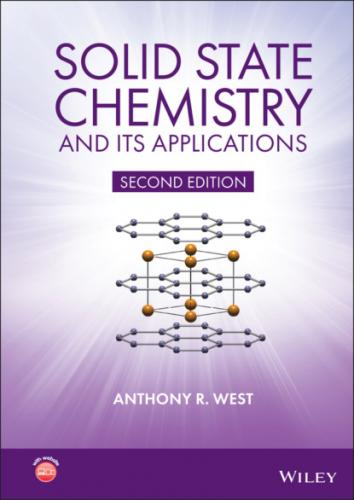The symmetry element described above for the silicate tetrahedron is a rotation axis, with symbol n. Rotation about this axis by 360/n degrees gives an identical orientation and the operation is repeated n times before the original configuration is regained. In this case, n = 3 and the axis is a threefold rotation axis. The SiO4 tetrahedron possesses four threefold rotation axes, one in the direction of each Si–O bond.
When viewed from another angle, SiO4 tetrahedra possess twofold rotation axes [Fig. 1.4(b)] which pass through the central Si and bisect the O–Si–O bonds. Rotation by 180° leads to indistinguishable orientations of the tetrahedra. The SiO4 tetrahedron possesses three of these twofold axes.
Crystals may display rotational symmetries 2, 3, 4 and 6. Others, such as n = 5, 7, are never observed in 3D crystal structures based on a regular periodic repetition of the unit cell and its contents. This is shown in Fig. 1.4(c), where a fruitless attempt has been made to pack pentagons to form a complete layer; thus, individual pentagons have fivefold symmetry but the array of pentagons does not. For hexagons with sixfold rotation axes (d), a complete layer is easily produced; both the individual hexagons and the overall array exhibit sixfold symmetry. This is not to say that molecules that have pentagonal symmetry, n = 5, cannot exist in the crystalline state. They can, of course, but their fivefold symmetry cannot be exhibited by the crystal as a whole.
Table 1.2 Symmetry elements
| Symmetry element | Hermann–Mauguin symbols (crystallography) | Schönflies symbols (spectroscopy) | |
|---|---|---|---|
| Point symmetry | Mirror plane | m | σ v, σ h |
| Rotation axis | n = 2, 3, 4, 6 | C n (C 2, C 3, etc.) | |
| Inversion axis |
|
– | |
| Alternating axisa | – | S n (S 1, S 2, etc.) | |
| Centre of symmetry |
|
i | |
| Space symmetry | Glide plane | a, b, c, d, n | – |
| Screw axis | 21, 31, etc. | – |
a The alternating axis is a combination of rotation (n‐fold) and reflection perpendicular to the rotation axis. It is little used in crystallography.
1.2.2 Quasicrystals
The discovery of a new state of matter, the quasicrystalline state, by Schechtman and colleagues, published in 1984 (and which led to the Nobel Prize in Chemistry in 2011) appeared at first sight to violate the rules concerning allowable rotational symmetries in crystal lattices. From their single‐crystal diffraction patterns, rotational symmetries such as n = 5 but also n = 10 and 12 were observed whereas, as shown in Fig. 1.4(c), a regular crystal lattice exhibiting fivefold rotational symmetry cannot exist. The answer to this conundrum is that quasicrystals do not have regularly repeating crystal structures based on a single unit cell motif. Instead, they have fully ordered but non‐periodic arrays constructed from more than one motif or building block.
Elegant examples of quasisymmetry are found in so‐called Penrose tiling, as shown in Fig. 1.5. In this example, space is filled completely by a combination of red and blue diamonds; such a tiling pattern has many local areas of fivefold symmetry but the structure as a whole is not periodic, does not exhibit fivefold symmetry and a regular repeat unit cannot be identified. Quasicrystals have since been discovered in a wide range of alloy systems and also in organic polymer and liquid crystal systems; they have been discovered in Nature in an Al–Cu–Fe alloy named icosahedrite that was believed to have been part of a meteorite and had existed on Earth for billions of years. It is probably just a matter of time before they are discovered also in inorganic oxide materials, natural or synthetic.
Figure 1.5 Two‐dimensional Penrose tiling constructed by packing together two different sets of parallelograms. C. Janot, Quasicrystals: A Primer, Oxford University Press (1997). Penrose was co‐recipient of the 2020 Nobel Prize in physics, in a totally different area to quasicrystals and Penrose tiling, for ‘discovery that black hole formation is a robust prediction of the general theory of relativity’.
Figure 1.6 Hypothetical twinned structure showing fivefold symmetry.
Adapted from J. M. Dubois, Useful Quasicrystals, World Scientific Publishing Company (2005).
In the early days of work on quasicrystals, an alternative explanation for possible fivefold symmetry was based on twinning, as shown schematically in Fig. 1.6. Five identical crystalline segments are shown, each of which has twofold rotational symmetry in projection. Pairs of crystal segments meet at a coherent interface or twin plane in which the structures on either side of the twin plane are mirror images of each other. The five crystal segments meet at a central point which exhibits fivefold symmetry as a macroscopic element of point symmetry but the individual crystal segments clearly do not exhibit any fivefold symmetry. Schechtman showed conclusively that twinning such as shown in Fig. 1.6 could not explain the quasicrystalline state.
The discovery of quasicrystals without long range periodicity and an identifiable unit cell, has forced the International Union of Crystallography to reconsider what is meant by a ‘crystal’. Since well‐prepared quasicrystals have highly ordered structures, many of which are thermodynamically stable and give sharp single crystal diffraction patterns, quasicrystals need to have a home in a wider definition of crystallinity. The requirement for crystallinity to be associated
